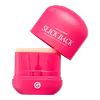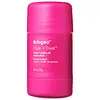What's inside
What's inside
 Key Ingredients
Key Ingredients

 Benefits
Benefits

 Concerns
Concerns

 Ingredients Side-by-side
Ingredients Side-by-side

Ricinus Communis Seed Oil
MaskingHydrogenated Castor Oil
EmollientHelianthus Annuus Seed Oil
EmollientVitis Vinifera Seed Oil
EmollientHelianthus Annuus Seed Wax
Skin ConditioningEuphorbia Cerifera Wax
Parfum
MaskingPlukenetia Volubilis Seed Oil
EmollientTetramethyl Acetyloctahydronaphthalenes
MaskingLimnanthes Alba Seed Oil
Skin ConditioningTocopheryl Acetate
AntioxidantPropanediol
SolventWater
Skin ConditioningGlycerin
HumectantHelianthus Annuus Leaf/Stem Extract
Skin ConditioningBeta Vulgaris
Cosmetic ColorantCitrus Grandis Fruit Extract
AstringentPanax Ginseng Root Extract
EmollientNelumbo Nucifera Seed Extract
AntimicrobialPorphyra Umbilicalis Extract
Skin ConditioningJuniperus Virginiana Oil
MaskingPotassium Sorbate
PreservativeSodium Benzoate
MaskingLinalool
PerfumingCitric Acid
BufferingHydrolyzed Rice Protein
Skin ConditioningThiamine Nitrate
Skin ConditioningNiacinamide
SmoothingLimonene
PerfumingRicinus Communis Seed Oil, Hydrogenated Castor Oil, Helianthus Annuus Seed Oil, Vitis Vinifera Seed Oil, Helianthus Annuus Seed Wax, Euphorbia Cerifera Wax, Parfum, Plukenetia Volubilis Seed Oil, Tetramethyl Acetyloctahydronaphthalenes, Limnanthes Alba Seed Oil, Tocopheryl Acetate, Propanediol, Water, Glycerin, Helianthus Annuus Leaf/Stem Extract, Beta Vulgaris, Citrus Grandis Fruit Extract, Panax Ginseng Root Extract, Nelumbo Nucifera Seed Extract, Porphyra Umbilicalis Extract, Juniperus Virginiana Oil, Potassium Sorbate, Sodium Benzoate, Linalool, Citric Acid, Hydrolyzed Rice Protein, Thiamine Nitrate, Niacinamide, Limonene
Ricinus Communis Seed Oil
MaskingCoco-Caprylate/Caprate
EmollientEuphorbia Cerifera Wax
Vitis Vinifera Seed Oil
EmollientHydrogenated Castor Oil
EmollientOleic/Linoleic/Linolenic Polyglycerides
EmollientStearyl Behenate
EmollientCopernicia Cerifera Wax
Helianthus Annuus Seed Wax
Skin ConditioningRosa Canina Fruit Oil
EmollientCocos Nucifera Oil
MaskingArgania Spinosa Kernel Oil
EmollientGlyceryl Stearate Se
EmulsifyingPrunus Domestica Seed Oil
Skin ConditioningCitrus Junos Peel Extract
Skin ConditioningOlea Europaea Oil Unsaponifiables
Skin ConditioningShorea Robusta Resin
TonicRhus Verniciflua Peel Wax
Kaolin
AbrasiveHelianthus Annuus Seed Oil
EmollientPanthenol
Skin ConditioningNiacinamide
SmoothingBiotin
AntiseborrhoeicFolic Acid
Skin ConditioningSodium Starch Octenylsuccinate
AbsorbentMaltodextrin
AbsorbentCalcium Pantothenate
Sodium Ascorbyl Phosphate
AntioxidantTocopheryl Acetate
AntioxidantPyridoxine Hcl
Skin ConditioningSilica
AbrasiveParfum
MaskingRicinus Communis Seed Oil, Coco-Caprylate/Caprate, Euphorbia Cerifera Wax, Vitis Vinifera Seed Oil, Hydrogenated Castor Oil, Oleic/Linoleic/Linolenic Polyglycerides, Stearyl Behenate, Copernicia Cerifera Wax, Helianthus Annuus Seed Wax, Rosa Canina Fruit Oil, Cocos Nucifera Oil, Argania Spinosa Kernel Oil, Glyceryl Stearate Se, Prunus Domestica Seed Oil, Citrus Junos Peel Extract, Olea Europaea Oil Unsaponifiables, Shorea Robusta Resin, Rhus Verniciflua Peel Wax, Kaolin, Helianthus Annuus Seed Oil, Panthenol, Niacinamide, Biotin, Folic Acid, Sodium Starch Octenylsuccinate, Maltodextrin, Calcium Pantothenate, Sodium Ascorbyl Phosphate, Tocopheryl Acetate, Pyridoxine Hcl, Silica, Parfum
Ingredients Explained
These ingredients are found in both products.
Ingredients higher up in an ingredient list are typically present in a larger amount.
Helianthus Annuus Seed Oil is the oil derived from the seeds of a Sunflower. Sunflower seed oil is non-fragrant. It is an emollient, meaning it helps to soften the skin.
Sunflower seed oil contains many fatty acids. The fatty acids found in sunflower seeds include (from highest amount to least): linoleic acid, myristic acid, palmitic acid, stearic acid, arachidic acid, oleic acid, and linolenic acid.
These fatty acids help the skin create ceramides. Ceramides play a role in repairing the skin barrier.
Helianthus Annuus Seed Oil helps moisturize the skin. This in turn helps the skin look more rejuvenated and smoother.
Sunflowers are rich in vitamin E.
Historians believe Indigenous cultures of North America domesticated sunflowers before corn. Thus they relied on sunflower oil for a variety of uses. One such use is moisturizing skin and hair.
Sunflower seed oil may not be fungal acne safe. We recommend speaking with a professional if you have any concerns.
Learn more about Helianthus Annuus Seed OilHelianthus Annuus Seed Wax is created from the common sunflower.
Sunflower seed wax is made up of long chain non-glyceride esters, a small amount of fatty alcohols, and fatty acids.
This ingredient is often used to enhance the texture of products. The fatty acid properties also help hydrate the skin.
Learn more about Helianthus Annuus Seed WaxHydrogenated Castor Oil is created by adding hydrogen to castor oil. This helps stabilize the castor oil and raises the melting point. At room temperature, hydrogenated castor oil is solid.
Castor Oil helps moisturize the skin. It is rich in a fatty acid called ricinoleic acid. This fatty acid helps prevent moisture loss on the skin. This helps keep your skin soft and hydrated. Ricinoleic acid also has anti-inflammatory and pain reducing properties.
As a wax-like substance, Hydrogenated Castor Oil acts as an emollient. Emollients help keep your skin stay soft and smooth by creating a barrier. This barrier helps trap moisture.
Hydrogenated Castor Oil may not be fungal-acne safe. We recommend speaking with a professional.
Learn more about Hydrogenated Castor OilNiacinamide is a multitasking form of vitamin B3 that strengthens the skin barrier, reduces pores and dark spots, regulates oil, and improves signs of aging.
And the best part? It's gentle and well-tolerated by most skin types, including sensitive and reactive skin.
You might have heard of "niacin flush", or the reddening of skin that causes itchiness. Niacinamide has not been found to cause this.
In very rare cases, some individuals may not be able to tolerate niacinamide at all or experience an allergic reaction to it.
If you are experiencing flaking, irritation, and dryness with this ingredient, be sure to double check all your products as this ingredient can be found in all categories of skincare.
When incorporating niacinamide into your routine, look out for concentration amounts. Typically, 5% niacinamide provides benefits such as fading dark spots. However, if you have sensitive skin, it is better to begin with a smaller concentration.
When you apply niacinamide to your skin, your body converts it into nicotinamide adenine dinucleotide (NAD). NAD is an essential coenzyme that is already found in your cells as "fuel" and powers countless biological processes.
In your skin, NAD helps repair cell damage, produce new healthy cells, support collagen production, strengthen the skin barrier, and fight environmental stressors (like UV and pollution).
Our natural NAD levels start to decline with age, leading to slower skin repair, visible aging, and a weaker skin barrier. By providing your skin niacinamide, you're recharging your skin's NAD levels. This leads to stronger, healthier, and younger looking skin.
Another name for vitamin B3 is nicotinamide. This vitamin is water-soluble and our bodies don't store it. We obtain Vitamin B3 from either food or skincare. Meat, fish, wheat, yeast, and leafy greens contain vitamin B3.
The type of niacinamide used in skincare is synthetically created.
Learn more about NiacinamideParfum is a catch-all term for an ingredient or more that is used to give a scent to products.
Also called "fragrance", this ingredient can be a blend of hundreds of chemicals or plant oils. This means every product with "fragrance" or "parfum" in the ingredients list is a different mixture.
For instance, Habanolide is a proprietary trade name for a specific aroma chemical. When used as a fragrance ingredient in cosmetics, most aroma chemicals fall under the broad labeling category of “FRAGRANCE” or “PARFUM” according to EU and US regulations.
The term 'parfum' or 'fragrance' is not regulated in many countries. In many cases, it is up to the brand to define this term.
For instance, many brands choose to label themselves as "fragrance-free" because they are not using synthetic fragrances. However, their products may still contain ingredients such as essential oils that are considered a fragrance by INCI standards.
One example is Calendula flower extract. Calendula is an essential oil that still imparts a scent or 'fragrance'.
Depending on the blend, the ingredients in the mixture can cause allergies and sensitivities on the skin. Some ingredients that are known EU allergens include linalool and citronellol.
Parfum can also be used to mask or cover an unpleasant scent.
The bottom line is: not all fragrances/parfum/ingredients are created equally. If you are worried about fragrances, we recommend taking a closer look at an ingredient. And of course, we always recommend speaking with a professional.
Learn more about ParfumRicinus Communis Seed Oil is the INCI name for castor oil.
Castor Oil helps moisturize the skin. It is rich in a fatty acid called ricinoleic acid. This fatty acid helps prevent moisture loss on the skin. This helps keep your skin soft and hydrated. Ricinoleic acid also has anti-inflammatory and pain reducing properties.
Besides hydrating the skin, castor oil is also used to hydrate hair. By keeping the hair shaft moisturized, breakage is decreased. More studies are needed to show castor oil's effective on stimulating hair growth.
Castor oil is created by cold-pressing castor seeds and then purifying the oil with heat. It was used in Ancient Egypt as fuel in lamps and to help treat eye irritation.
The term 'fragrance' is not regulated in many countries. In many cases, it is up to the brand to define this term. For instance, many brands choose to label themselves as "fragrance-free" because they are not using synthetic fragrances. However, their products may still contain ingredients such as essential oils that are considered a fragrance.
Learn more about Ricinus Communis Seed OilTocopheryl Acetate is AKA Vitamin E. It is an antioxidant and protects your skin from free radicals. Free radicals damage the skin by breaking down collagen.
One study found using Tocopheryl Acetate with Vitamin C decreased the number of sunburned cells.
Tocopheryl Acetate is commonly found in both skincare and dietary supplements.
Learn more about Tocopheryl AcetateVitis Vinifera Seed Oil comes from the grape vine. Grape seeds are a byproduct of creating grape juice or wine.
The components of grape seeds have many skin benefits. Research has found it to be antimicrobial and anti-inflammatory. It also contains many potent antioxidants such as Vitamin E , Vitamin C, proanthocyanidins, polyphenols, flavonoids, and anthocyanins. Proanthocyanidin has been shown to help even out skin tone.
Antioxidants help fight free-radical molecules. Free-radical molecules are capable of damaging our cells and other genetic material. Antioxidants help stabilize free-radicals by donating extra electrons. Grape seed extract may help reduce the signs of aging.
The antimicrobial properties of grape seed may help treat acne. However, more research is needed to support this claim.
Grape seed has also been found to help absorb UV rays. Grape seed extract should not replace your sunscreen.
The fatty acids of grape seed oil give it emollient properties. Emollients help soothe and soften your skin by creating a film. This film traps moisture within, keeping your skin hydrated.
Learn more about Vitis Vinifera Seed OilEuphorbia Cerifera wax comes from a shrub in Northern Mexico. It is used to stabilize formulations and has emollient properties.
Emollients form a thin layer on top of skin to prevent water from evaporating, keeping skin and lips hydrated.
According to a manufacturer, this wax can range from a yellow/brown color to translucent.
Learn more about Euphorbia Cerifera Wax